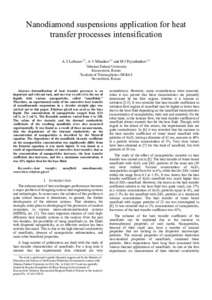Nanodiamond Suspensions Application for Heat Transfer Processes Intensification
Скачать файл:
URI (для ссылок/цитирований):
https://ieeexplore.ieee.org/document/8602772https://elib.sfu-kras.ru/handle/2311/129241
Автор:
Лобасов, А. С.
Минаков, А. В.
Пряжников, М. И.
Коллективный автор:
Научно-исследовательская часть
Дата:
2019-01Журнал:
2018 International Multi-Conference on Industrial Engineering and Modern Technologies, FarEastCon 2018Квартиль журнала в Scopus:
без квартиляКвартиль журнала в Web of Science:
без квартиляБиблиографическое описание:
Лобасов, А. С. Nanodiamond Suspensions Application for Heat Transfer Processes Intensification [Текст] / А. С. Лобасов, А. В. Минаков, М. И. Пряжников // 2018 International Multi-Conference on Industrial Engineering and Modern Technologies, FarEastCon 2018: 2018 International Multi-Conference on Industrial Engineering and Modern Technologies, FarEastCon 2018. — 2019. — № 8602772. — С. 1-5Аннотация:
Intensification of heat transfer processes is an important and relevant task, and one way to solve it is the use of liquids with various nanoparticles, called “nanofluids.” Therefore, an experimental study of the convective heat transfer of nanodiamonds suspensions in a circular straight pipe was carried out in this paper. Ethylene glycol was used as the base liquid. The concentration of nanoparticles ranged from 0.25 vol.% to 2 vol.%. The Reynolds numbers varied from 5 to 100. The values of the viscosity and the thermal conductivity coefficients of the resulting nanofluids were also measured experimentally. It was found as a result of these measurements, that the dependence of the thermal conductivity on the concentration of nanoparticles is described by the Maxwell equation. The dependence of the nanofluids viscosity coefficient on the nanoparticles concentration was significantly differ from the Einstein equation, it was much higher. It was found as a result of experimental studies of convective heat transfer, that as the concentration of nanoparticles increases, the heat transfer coefficient also increases, and for a maximum concentration, it was 15% higher then for the base fluid.

